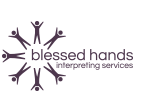American Sign Language Instruction
American Sign Language Instruction
Broadening your Customer Base
Our Simply ASL class teaches American Sign Language to anyone who is interested in learning how to communicate and interact with deaf, hard of hearing and deaf/blind persons. American Sign Language – ASL – is a visual language. With signing, the brain processes linguistic information through the eyes. The shape, placement, and movement of the hands, as well as facial expressions and body movements, all play important parts in conveying information.
Sign language is not a universal language – each country has its own sign language, and regions have dialects, much like the many languages spoken all over the world. Like any spoken language, ASL is a language with its own unique rules of grammar and syntax. Like all languages, ASL is a living language that grows and changes over time.
ASL is used predominantly in the United States and in many parts of Canada. ASL is accepted by many high schools, colleges, and universities in fulfillment of modern and “foreign” language academic degree requirements across the United States. Source: https://www.nad.org/resources/american-sign-language/what-is-american-sign-language/
ASL is the language used by the Deaf community, which is comprised of individuals who are deaf, hard of hearing and deaf/blind.
“I think learning ASL is advantageous in any job where you interact with the public, or where you sell your services to the public. Certainly people like teachers, doctors, nurses, EMTs, police officers, etc. would benefit from learning ASL. It can also broaden your customer base. … Learning ASL can increase the number of people that you can do business with … And, yes, if you like languages, then I definitely recommend learning ASL. Because it’s fascinating. :)” Emily Hart, Is There An Advantage to Learning ASL? from Quora
Whether you are an employee, co-worker or colleague, this class explains how to receive, service, communicate and accommodate deaf persons in any type of business or social setting.
Broadening your Customer Base
Our Simply ASL class teaches American Sign Language to anyone who is interested in learning how to communicate and interact with deaf, hard of hearing and deaf/blind persons. American Sign Language – ASL – is a visual language. With signing, the brain processes linguistic information through the eyes. The shape, placement, and movement of the hands, as well as facial expressions and body movements, all play important parts in conveying information.
Sign language is not a universal language – each country has its own sign language, and regions have dialects, much like the many languages spoken all over the world. Like any spoken language, ASL is a language with its own unique rules of grammar and syntax. Like all languages, ASL is a living language that grows and changes over time.
ASL is used predominantly in the United States and in many parts of Canada. ASL is accepted by many high schools, colleges, and universities in fulfillment of modern and “foreign” language academic degree requirements across the United States. Source: https://www.nad.org/resources/american-sign-language/what-is-american-sign-language/
ASL is the language used by the Deaf community, which is comprised of individuals who are deaf, hard of hearing and deaf/blind.
“I think learning ASL is advantageous in any job where you interact with the public, or where you sell your services to the public. Certainly people like teachers, doctors, nurses, EMTs, police officers, etc. would benefit from learning ASL. It can also broaden your customer base. … Learning ASL can increase the number of people that you can do business with … And, yes, if you like languages, then I definitely recommend learning ASL. Because it’s fascinating. :)” Emily Hart, Is There An Advantage to Learning ASL? from Quora
Whether you are an employee, co-worker or colleague, this class explains how to receive, service, communicate and accommodate deaf persons in any type of business or social setting.

